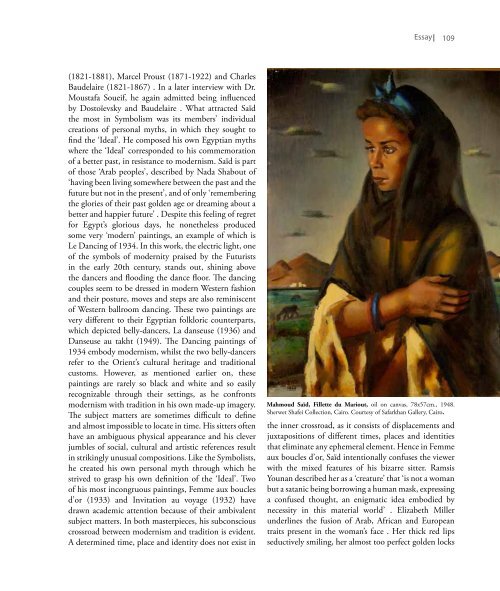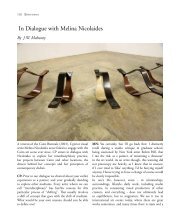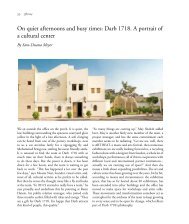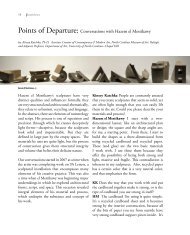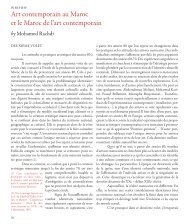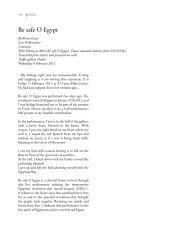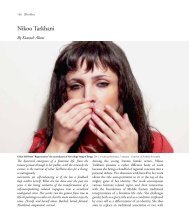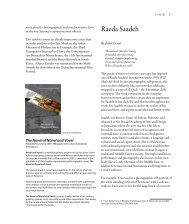full essay - Contemporary Practices
full essay - Contemporary Practices
full essay - Contemporary Practices
- No tags were found...
Create successful ePaper yourself
Turn your PDF publications into a flip-book with our unique Google optimized e-Paper software.
Essay109(1821-1881), Marcel Proust (1871-1922) and CharlesBaudelaire (1821-1867) . In a later interview with Dr.Moustafa Soueif, he again admitted being influencedby Dostoïevsky and Baudelaire . What attracted Saïdthe most in Symbolism was its members’ individualcreations of personal myths, in which they sought tofind the ‘Ideal’. He composed his own Egyptian mythswhere the ‘Ideal’ corresponded to his commemorationof a better past, in resistance to modernism. Saïd is partof those ‘Arab peoples’, described by Nada Shabout of‘having been living somewhere between the past and thefuture but not in the present’, and of only ‘rememberingthe glories of their past golden age or dreaming about abetter and happier future’ . Despite this feeling of regretfor Egypt’s glorious days, he nonetheless producedsome very ‘modern’ paintings, an example of which isLe Dancing of 1934. In this work, the electric light, oneof the symbols of modernity praised by the Futuristsin the early 20th century, stands out, shining abovethe dancers and flooding the dance floor. The dancingcouples seem to be dressed in modern Western fashionand their posture, moves and steps are also reminiscentof Western ballroom dancing. These two paintings arevery different to their Egyptian folkloric counterparts,which depicted belly-dancers, La danseuse (1936) andDanseuse au takht (1949). The Dancing paintings of1934 embody modernism, whilst the two belly-dancersrefer to the Orient’s cultural heritage and traditionalcustoms. However, as mentioned earlier on, thesepaintings are rarely so black and white and so easilyrecognizable through their settings, as he confrontsmodernism with tradition in his own made-up imagery.The subject matters are sometimes difficult to defineand almost impossible to locate in time. His sitters oftenhave an ambiguous physical appearance and his cleverjumbles of social, cultural and artistic references resultin strikingly unusual compositions. Like the Symbolists,he created his own personal myth through which hestrived to grasp his own definition of the ‘Ideal’. Twoof his most incongruous paintings, Femme aux bouclesd’or (1933) and Invitation au voyage (1932) havedrawn academic attention because of their ambivalentsubject matters. In both masterpieces, his subconsciouscrossroad between modernism and tradition is evident.A determined time, place and identity does not exist inMahmoud Saïd, Fillette du Mariout, oil on canvas, 78x57cm., 1948.Sherwet Shafei Collection, Cairo. Courtesy of Safarkhan Gallery, Cairo.the inner crossroad, as it consists of displacements andjuxtapositions of different times, places and identitiesthat eliminate any ephemeral element. Hence in Femmeaux boucles d’or, Saïd intentionally confuses the viewerwith the mixed features of his bizarre sitter. RamsisYounan described her as a ‘creature’ that ‘is not a womanbut a satanic being borrowing a human mask, expressinga confused thought, an enigmatic idea embodied bynecessity in this material world’ . Elizabeth Millerunderlines the fusion of Arab, African and Europeantraits present in the woman’s face . Her thick red lipsseductively smiling, her almost too perfect golden locks


